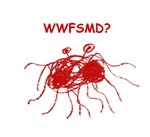Turin Shroud confirmed as a fake
Turin Shroud confirmed as a fake: French science magazine - Yahoo! News
In a related story, Florida Governor Jeb Bush dismissed the scientific evidence as irrelevant and announced that he intended to open an investigation into whether Michael Schiavo was responsible for planting the fake shroud in a French church in the year 1357.
PARIS (AFP) - A French magazine said it had carried out experiments that proved the Shroud of Turin, believed by some Christians to be their religion's holiest relic, was a fake.
"A mediaeval technique helped us to make a Shroud," Science et Vie (Science and Life) said in its July issue.
...
It bears the faint image of a blood-covered man with holes in his hand and wounds in his body and head, the apparent result of being crucified, stabbed by a Roman spear and forced to wear a crown of thorns.
In 1988, scientists carried out carbon-14 dating of the delicate linen cloth and concluded that the material was made some time between 1260 and 1390. Their study prompted the then archbishop of Turin, where the Shroud is stored, to admit that the garment was a hoax. But the debate sharply revived in January this year.
Drawing on a method previously used by skeptics to attack authenticity claims about the Shroud, Science et Vie got an artist to do a bas-relief -- a sculpture that stands out from the surrounding background -- of a Christ-like face.
A scientist then laid out a damp linen sheet over the bas-relief and let it dry, so that the thin cloth was moulded onto the face.
Using cotton wool, he then carefully dabbed ferric oxide, mixed with gelatine, onto the cloth to make blood-like marks. When the cloth was turned inside-out, the reversed marks resulted in the famous image of the crucified Christ.
Gelatine, an animal by-product rich in collagen, was frequently used by Middle Age painters as a fixative to bind pigments to canvas or wood.
The imprinted image turned out to be wash-resistant, impervious to temperatures of 250 C (482 F) and was undamaged by exposure to a range of harsh chemicals, including bisulphite which, without the help of the gelatine, would normally have degraded ferric oxide to the compound ferrous oxide.
The experiments, said Science et Vie, answer several claims made by the pro-Shroud camp, which says the marks could not have been painted onto the cloth.
In a related story, Florida Governor Jeb Bush dismissed the scientific evidence as irrelevant and announced that he intended to open an investigation into whether Michael Schiavo was responsible for planting the fake shroud in a French church in the year 1357.






0 Comments:
Post a Comment
<< Home